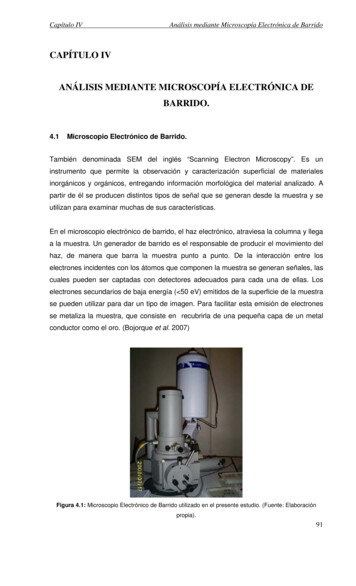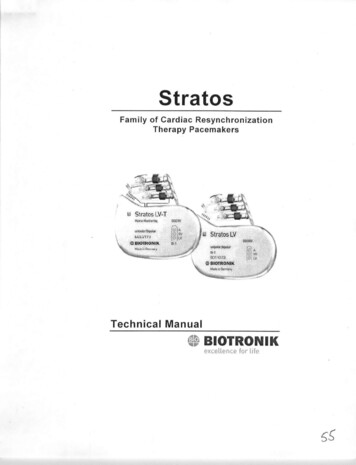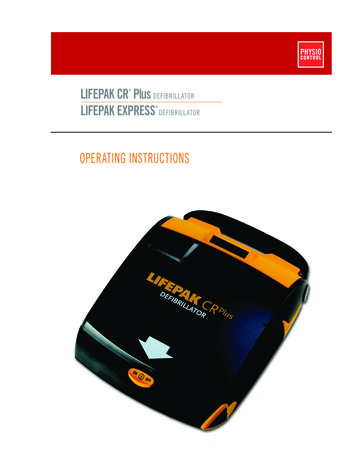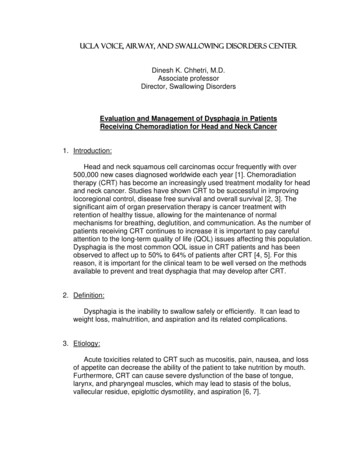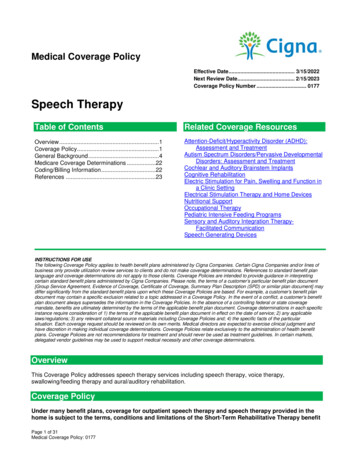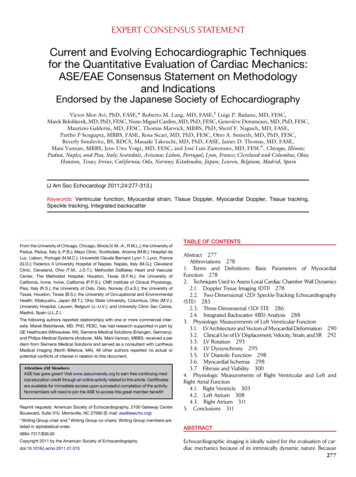
Transcription
AL07-07April 18, 2007Item:Boston Scientific Corporation’s Cardiac Rhythm Management Division (previouslycalled Guidant) recall of Implantable Cardiac Defibrillators (ICDs) and CardiacResynchronization Therapy Defibrillators (CRT-Ds).Specific Incident:The following Guidant ICD and CRT-D device models have low-voltagecapacitors that may be subject to degradation and may cause accelerated batterydepletion.Device NameVitality DS DR/VRVitality EL DRVitality AVTVitality 2 DR/VRVitality 2 EL DR/VRVitality DR HEContak Renewal 3Contak Renewal 3 HEContak Renewal 4Contak Renewal 4 HEContak Renewal 3 RFContak Renewal 3 RF HEContak Renewal 4 RFContak Renewal 4 RF HEContak Renewal 4 AVTContak Renewal 4 AVT HEActions:Model H230/H235H239M170/M175M177/M1791. Within 14 calendar days, electrophysiology/cardiology staff or otherappropriate caregivers must identify all affected patients by implementing eachof the following steps a through c. It is important that ALL INFORMATIONsources be reviewed to insure that patients will not be missed, as they may befound on one list and not on another.a) Review the manufacturers letters (see the links under AdditionalInformation).b) Retrieve and review a list of your patients with the affected devices(ICDs and CRT-Ds) on the VA National ICD Surveillance Center intranetwebsite (https://icd.sanfrancisco.med.va.gov, VA Only, see Attachment 2for instructions). This list consists of all the patients in Guidant’s databasethat have implanted devices affected by this and previous recalls (somedevices are affected by more than one recall).c) Review your patient records for all patients with implanted Guidantdevices affected by this recall.AL07-07Page 1 of 5
2. Within the next 30 calendar days, follow the actions contained in Attachment1. This guidance was prepared by Dr. Edmund Keung, Director of the VANational ICD Surveillance Center, as the best course of action for yourpatients.NOTE: Because the incidence rate is very low and early battery depletion canbe identified with close monitoring (see information contained within the linksbelow), premature replacement of the devices is not recommended.Addl Information:Boston Scientific sent letters to physicians and patients notifying them of this risk.(See links below for letters and FDA’s Q&As.)a. Boston Scientific dear doctor letter, dated April 5, 2007.http://www.guidant.com/physician communications/ap shortened replacement phy 040507.pdfb. Boston Scientific dear patient letter, dated April 5, AP Shortened Replacement Window.pdfc. FDA’s Questions and Answers on Boston Scientific/Guidant Recall,dated April 10, mld. Guidant Device Lookup/Search for affected ookup.jsp?lang en&cc USAttachments:1) VA National ICD Surveillance Center Memo dated April 18, 20072) Instructions to access the VA National ICD Surveillance CenterSource:Boston Scientific CorporationContacts:Larry Retzlaff at Guidant (800) 227- 3422 Ext. 24279Dr. Edmund Keung at VA National ICD Surveillance Center at(415) 221-4810 Ext. 3182Bryanne Patail at National Center for Patient Safety (NCPS) at(734) 930-5890AL07-07Page 2 of 5
ATTACHMENT 1VA National ICD Surveillance Center MemoDEPARTMENT OF VETERANS AFFAIRSMedical Center4150 Clement StreetSan Francisco CA 94121VA National ICD Surveillance CenterApril 18, 2007Dear colleagues:This document is to provide you with some general guidelines to deal with the most recent Product Advisoryissued by Boston Scientific on April 5, 2007, regarding a subset of Guidant ICDs and CRT-Ds. This issue hasbeen classified by FDA on April 10, 2007, as a recall.Devices affected:Device NameVitality DS DR/VRVitality EL DRVitality AVTVitality 2 DR/VRVitality 2 EL DR/VRVitality DR HEContak Renewal 3Contak Renewal 3 HEContak Renewal 4Contak Renewal 4 HEContak Renewal 3 RFContak Renewal 3 RF HEContak Renewal 4 RFContak Renewal 4 RF HEContak Renewal 4 AVTContak Renewal 4 AVT HEModel H230/H235H239M170/M175M177/M179The Problem: The root cause: Degradation of low-voltage capacitors. Performance failure: Acceleration of battery depletion which may result in reduced time between electivereplacement indicator (ERI) and end of life (EOL) to less than 3 months. Reported incidence of accelerated battery depletion 19/73,000 devices ( 0.026%).Guidant estimated 2% of this device population may exhibit a shortened ERI to EOL time. Guidant reported no deaths or series injuries in association with this recall.Recommendations: Because the incidence rate is very low and early battery depletion can be identified with close monitoring(see below), replacement of the devices is not recommended.AL07-07Page 3 of 5
Perform an interrogation on your patients with the affected ICD and CRT-D and discuss this safety issuewith your patients as soon as you can (within 30 days as suggested by the VHA Patient Safety Alert). Use the following flowchart to determine if the device is at risk and monitoring intervals: It is strongly recommended that patients with the affected devices be remotely monitored by enrollingthem in the LATITUDE Patient Management System via the VA National ICD Surveillance Center(NISC). Contact your local Boston Scientific representative to schedule a training session for your staffon the LATITUDE program. After the training is completed, you can enroll patients with the affecteddevices on the NISC website (https://icd.sanfrancisco.med.va.gov). Document your actions in CPRS and update your patient information on the NISC website. These recommendations are only suggestions and are not binding. We have to evaluate individualpatient’s clinical conditions, advise the patients of the risks and benefits of specific treatment optioncompared to the level of device performance as reported and arrive at the best course of action. Asalways, you should make the final determination on a case-by-case basis regarding the appropriate actionfor your patients.Ed Keung, MDDirector, VA National ICD Surveillance CenterPh: 415-221-4810, extension 3182Edmund.Keung@va.govAL07-07Page 4 of 5
ATTACHMENT 2:Instructions on how to access the VA National ICD Surveillance Center databasePerform the following steps to access your patient list supplied by Guidant on the VA National ICD SurveillanceCenter:1. VA intranet URL: https://icd.sanfrancisco.med.va.gov2. You have to register as a user first. Len Roberts, our administrator (Leonard.Roberts@va.gov) willreview the information you provided and grant you access within 24 hours or less3. After you log in, click on Queries & Reports and Patient Device Search and Export .4. Select ICD Generator from the Filter by Device Type dropdown list.5. Select Guidant from the Filter by Manufacturer drop-down list.6. Leave the Search Model textbox blank if you want all Guidant models. Otherwise, enter a model number(e.g., T165).7. Use Select, FDA Recall/Alert and No recall/alert from the Alert dropdown list to filter yourpatient list to obtain all your patients with the device(s) identified in #6, with Guidant alerts, and yourpatients not affected by the alert, respectively. Some devices are affected by more than one recall.8. Click “Go” to obtain your listThe device alert status is listed in the far right corner under the column heading Alert (Y Yes). Do not forgetthat there may be more than one page for the list, depending on how many patients you have. You can exportthe table to an Excel spreadsheet or just print it.The medical centers listed under the column VAMC are the hospitals where they had their device implanted orthe follow-up clinics, according the records of the National ICD Surveillance Center and Boston Scientific.You will notice that some patients have SSN (social security number) of 888-88-7777 and phone numbers of(888)888-8888, (999)999-9999 or (415)221-4810. In these patients, Boston Scientific did not include their SSNand phone numbers in their list. Please update the information.347568AlertstatusAL07-07Page 5 of 5
them in the LATITUDE Patient Management System via the VA National ICD Surveillance Center (NISC). Contact your local Boston Scientific representative to schedule a training session for your staff on the LATITUDE program. After the training is completed, you can enroll patients with the affected

